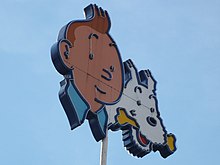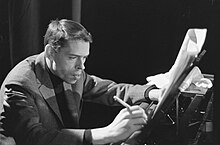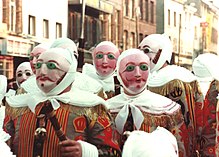Culture of Belgium


| Part of a series on the |
| Culture of Belgium |
|---|
 |
| History |
|
People |
| Languages |
|
Mythology and Folklore |
| Cuisine |
| Religion |
| Art |
| Music |
| Sport |
Belgian culture involves both the aspects shared by all Belgians regardless of the language they speak and the differences between the main cultural communities:
The territory corresponding to present-day Belgium having always been located at the meeting point of
Famous elements of the Belgian culture include gastronomy (
Since modern culture is more than ever related to languages (theatres, media, literature, etc), the modern Belgian cultural life has tended to develop in each linguistic community (with common elements however). Members of each of the two main linguistic groups generally make their cultural choices from within their own language community, and then, when going beyond, the
Minorities, such as the
Art
Painting

Belgium's contributions to painting have been especially rich. The
During the 19th and 20th centuries many original
Comics

Belgium has numerous well-known
Belgium is home to some of the most important European comics magazines and publishers, with Dupuis (Spirou magazine), Le Lombard (Tintin magazine) and Casterman.
Museums
Some of the most impressive museums in Belgium are the
Furthermore, the
Architecture

Examples of Belgian architecture include the
Belgian contributions to architecture also continued into the 19th and 20th centuries, including the work of Victor Horta and Henry van de Velde, who were major initiators of the Art Nouveau style in Belgium and abroad.[10][11]
Literature
Belgium has produced several well-known
Belgian literature was more cohesive in the past but is now divided based on linguistic lines. Until the mid-20th century, Belgian writers more often wrote in French even if they were Flemish, due both to the then-dominant position of that language in worldwide culture as well as within Belgium itself (e.g. Suzanne Lilar, Emile Verhaeren, and Maurice Maeterlinck). As the
Belgian francophone literature is sometimes difficult to distinguish from French literature as a whole, because several great French authors went to Belgium for refuge (e.g.
There have also been writers in the Walloon language, such as Nicolas Defrecheux and Edouard Remouchamps.
Cinema
Belgian films have been awarded several times at the Cannes Film Festival and in other less-known festivals. They are generally made with a small budget, and are mostly funded by the regional governments (the Vlaams Audiovisueel Fonds, and Wallimage, among others) and private corporations by means of sponsorship and product placement.
Famous Belgian directors include
Music

The
In the 19th and 20th centuries, there was an emergence of major violinists, such as Henri Vieuxtemps, Eugène Ysaÿe and Arthur Grumiaux. Adolphe Sax, the inventor of the saxophone, was born in Belgium, and so were many important classical composers. One of the most famous is César Franck, but Guillaume Lekeu and Wim Mertens are also noteworthy.
Contemporary
Belgium is also home to some very popular music festivals such as
Fashion
Belgium is also home to a number of successful fashion designers. For instance, in the 1980s, Antwerp's
Cuisine

Belgium is famous for beer, chocolate, waffles and French fries. The national dishes are "steak and fries", and "mussels with fries".[16][17][18][A] Many highly ranked Belgian restaurants can be found in the most influential restaurant guides, such as the Michelin Guide.[19] One of the many beers with high prestige is the ale produced by the Trappist monks. Traditionally each abbey's beer is served in its own glass (the forms, heights and widths are different). Six of the eleven breweries sanctioned to brew Trappist beer are Belgian.
Although Belgian gastronomy is connected to French cuisine, some
Brands of Belgian chocolate and pralines, like
Folklore

Folklore plays a major role in Belgium's cultural life; the country has a comparatively high number of processions,
Other examples are the three-day Carnival of Aalst in February or March; the still very religious processions of the Holy Blood taking place in Bruges in May, the Virga Jesse procession held every seven years in Hasselt, the annual procession of Hanswijk in Mechelen, the 15 August festivities in Liège, and the Walloon festival in Namur. Originated in 1832 and revived in the 1960s, the Gentse Feesten (a music and theatre festival organised in Ghent around Belgian National Day, on 21 July) have become a modern tradition. Several of these festivals include sporting competitions, such as cycling, and many fall under the category of kermesses.
A major non-official holiday (which is however not an official public holiday) is Saint Nicholas Day (Dutch: Sinterklaas, French: la Saint-Nicolas), a festivity for children, and in Liège, for students.[28] It takes place each year on 6 December and is a sort of early Christmas. On the evening of 5 December, before going to bed, children put their shoes by the hearth with water or wine and a carrot for Saint Nicholas's horse or donkey. According to tradition, Saint Nicholas comes at night and travels down the chimney. He then takes the food and water or wine, leaves presents, goes back up, feeds his horse or donkey, and continues on his course. He also knows whether children have been good or bad. This holiday is especially loved by children in Belgium and the Netherlands. Dutch immigrants imported the tradition into the United States, where Saint Nicholas is now known as Santa Claus.
See also
Notes
- ^ Contrarily to what the text suggests, the season starts as early as July and lasts through April.
- ^ The Dutch word ommegang is here used in the sense of an entirely or mainly non-religious procession, or the non-religious part thereof—see also its article on the Dutch-language Wikipedia; the Processional Giants of Brussels, Dendermonde and Mechelen mentioned in this paragraph are part of each city's ommegang. The French word ducasse refers also to a procession; the mentioned Processional Giants of Ath and Mons are part of each city's ducasse.
References
This article needs additional citations for verification. (December 2008) |
- ^ "Low Countries, 1000–1400 AD". Timeline of Art History. Metropolitan Museum of Art. 2007. Archived from the original on 15 April 2007. Retrieved 10 May 2007.
- ^ "Low Countries, 1400–1600 AD". Timeline of Art History. Metropolitan Museum of Art. 2007. Archived from the original on 29 April 2007. Retrieved 10 May 2007.
- ISBN 978-2-87114-026-9.
- ^ Guratzsch, Herwig (1979). Die große Zeit der niederländische Malerei (in German). Freiburg im Beisgau: Verlag Herder. p. 7.
- ^ "Low Countries, 1600–1800 AD". Timeline of Art History. Metropolitan Museum of Art. 2007. Archived from the original on 13 May 2007. Retrieved 10 May 2007.
- ^ "Art History: Flemish School: (1600–1800)—Artists: (biography & artworks)". World Wide Arts Resources. 5 February 2006. Archived from the original on 13 October 2009. Retrieved 10 May 2007.—A general presentation of the Flemish artistic movement with a list of its artists, linking to their biographies and artworks
- ^ "Belgian Artists: (biographies & artworks)". World Wide Arts Resources. 5 February 2006. Archived from the original on 15 May 2016. Retrieved 10 May 2007.—List of Belgian painters, linking to their biographies and artworks
- ^ Baudson, Michel (1996). "Panamarenko". Flammarion (Paris), quoted at presentation of the XXIII Bienal Internacional de São Paulo. Archived from the original on 7 February 2007. Retrieved 10 May 2007.
- ISBN 978-1-84545-588-0.
- ^ Brussels, capital of Art Nouveau (page 1) Archived 9 May 2007 at the Wayback Machine, "(page 2)". Senses Art Nouveau Shop, Brussels. 2007. Archived from the original on 4 March 2007. Retrieved 11 May 2007. (for example)
- World Heritage List. UNESCO. Archivedfrom the original on 13 May 2013. Retrieved 16 May 2007.
The appearance of Art Nouveau in the closing years of the 19th century marked a decisive stage in the evolution of architecture, making possible subsequent developments, and the Town Houses of Victor Horta in Brussels bear exceptional witness to its radical new approach.
- ^ A review of the Belgian cinema till about 2000 can be found at"History of Cinema in Belgium". Film Birth. 2007. Archived from the original on 14 September 2011. Retrieved 26 June 2011.
- ^ "Western music, the Franco-Flemish school". Encyclopædia Britannica. 2007. Archived from the original on 8 December 2006. Retrieved 15 May 2007.
Most significant musically was the pervasive influence of musicians from the Low Countries, whose domination of the music scene during the last half of the 15th century is reflected in the period designations the Netherlands school and the Franco-Flemish school.
- ^ Two comprehensive discussions of rock and pop music in Belgium since the 1950s:
"The Timeline—A brief history of Belgian Pop Music". The Belgian Pop & Rock Archives. Flanders Music Centre, Brussels. March 2007. Archived from the original on 12 July 2007. Retrieved 7 June 2007.
"Belgian Culture—Rock". Vanberg & DeWulf Importing. 2006. Archived from the original on 7 June 2007. Retrieved 11 May 2007. - ^ "Fashion and the 'Antwerp Six'". Dorset, UK: Fashion Worlds. 2004. Archived from the original on 19 April 2007. Retrieved 13 May 2007.
- ISBN 978-1-56305-411-2.
- ISBN 978-1-56305-411-2.
- ^ "Mussels". Visit Belgium. Official Site of the Belgian Tourist Office in the Americas. 2005. Archived from the original on 10 February 2007. Retrieved 12 August 2007.
- ^ "The Michelin stars 2007 in Belgium". Resto.be TM Dreaminvest. 2007. Archived from the original on 9 October 2008. Retrieved 15 May 2007.
- ISBN 978-1-86450-245-9.
- ^ Snick, Chris (18 October 2011). "Nieuwe bierbijbel bundelt alle 1.132 Belgische bieren". Het Nieuwsblad (in Dutch). Archived from the original on 5 June 2012.
- ^ "Nieuwe bierbijbel met 1.132 Belgische bieren voorgesteld in Brugge". Krant van West-Vlaanderen (in Dutch). 18 October 2011. Archived from the original on 31 May 2012. Retrieved 17 February 2012.
- ^ Ames, Paul (30 August 2009). "Buying the World's Best Beer". Global Post. Archived from the original on 9 November 2010. Retrieved 19 November 2010.
- ^ Guthrie, Tyler (11 August 2010). "Day trip to the best beer in the world". Chicago Tribune. Archived from the original on 4 December 2010. Retrieved 19 November 2010.
- ^ "Monks run short of 'world's best' beer". ABC. Reuters. 12 August 2005. Archived from the original on 10 March 2009. Retrieved 19 November 2010.
- ^ "InBev dividend 2006: 0.72 euro per share—infobox: About InBev" (Press release). InBev. 24 April 2007. Archived from the original on 11 September 2007. Retrieved 31 May 2007.
InBev is a publicly traded company (Euronext: INB) based in Leuven, Belgium. The company's origins date back to 1366, and today it is the leading global brewer by volume.
- ^ "Processional Giants and Dragons in Belgium and France". UNESCO. Archived from the original on 27 April 2007. Retrieved 15 May 2007.
- ^ "Folklore estudiantin liégeois" (in French). University of Liège. Archived from the original on 20 June 2010. Retrieved 17 June 2008.
